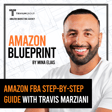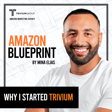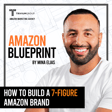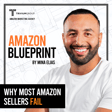Become a Creator today!Start creating today - Share your story with the world!
Start for free
00:00:00
00:00:01

Amazon suspended my listing... Don't make these mistakes
Description:
In this episode, I share two critical mistakes I made on Amazon that cost me 90% of my revenue overnight, despite my years of expertise and success on the platform.
After managing many brands and generating millions in revenue, I faced the consequences of these errors, resulting in my listing getting suspended on Amazon.
Each mistake has the potential to cause significant financial loss, so learn from my experience and avoid repeating these mistakes.
Get your FREE Amazon account audit by my team: https://triviumco.com/get-free-audit/
Transcript
Introduction and Revenue Loss Experience
00:00:00
Speaker
Welcome back to the Amazon Blueprint Podcast.
00:00:05
Speaker
I lost 90% of my revenue on Amazon literally overnight because of two stupid mistakes. Mistakes I thought I would never make. I thought I was an Amazon expert. I've been selling on Amazon for five years, made millions of dollars on Amazon. I have over 185 brands that we're running ads for right now and marketing on Amazon for. And I still made two stupid mistakes. It
Amazon Compliance Warning and Response Failure
00:00:24
Speaker
resulted in two of my listings getting taken down. And in this video, I'm going to cover exactly those two mistakes and five very common mistakes brands on Amazon are usually making. I want to cover them. And I want you to pay attention to each and every one because they will result in you losing tens if not hundreds of thousands of dollars from each of those mistakes. All right. So how did I lose 90 percent of my revenue? How did I lose it overnight? I got an email from Amazon from the food and safety department saying, hey, you have some sort of like notification, some warning. I'm reading this thing.
00:00:52
Speaker
And basically what it says is someone reported saying that like they were shitting too much, literally shitting too much when taking my product. And so blah, blah, blah, whatever. And at that point, my listing is still
Essential Legal and Documentation Practices
00:01:03
Speaker
fine. But Amazon says, you have to reply to us answering these five questions in the next one business day or else we're going to take you down. So I forwarded to my brand manager. I said, hey, can you handle this? He replied back to me saying, hey, I need your GMP, your certificate of good manufacturing practices. I said, okay, I'll go get it and I'll get back to you. So instead of him saying anything and saying, hey, we're working on it, we're gonna get it it you know a little bit more than one business day, whatever, he didn't remind me that it was going to be one business day before they were gonna shut me down. And honestly, I take full ownership. I'm not trying to put the blame on anyone. I should have been more aware of this, but the one business day passed and I was still waiting for my new manufacturer to send me the CGMP certification. And so basically what they said was you didn't respond to us in one business day and as a result, we are taking you down. And they took me down, they blocked my listing and they said, we'll put it back up as soon as you give us answers and certification and certificate of analysis and all of that good stuff. And as a result, for five, six, seven days, I lost a lot of revenue because of one stupid mistake because I did not have all of my legal documents, my certificates and all that stuff ready from my manufacturer. Now, here's what I would do different.
00:02:10
Speaker
I will make sure that every 90 days I have an up-to-date certificate of analysis and CGMP. If this ever happens again, I need to be able to send the documents right away to Amazon and say, hey, here you go. Moral of the first mistake, make sure you respond to Amazon in a timely manner and make sure that you always have all of your paperwork and all of your documentation ready if Amazon ever needs it. Mistake
Inventory Mismanagement and Solutions
00:02:32
Speaker
number two, and I'm embarrassed to even say it, running out of stock. Now you're going to be like me, now there's no way someone that is a veteran like you just ran out of stock. You're right. I didn't run out of stock. This is what happened. I had three weeks of inventory left at Amazon. This is when I expected my shipment to arrive to Amazon. And my shipment did arrive to Amazon. There was enough units for an additional 60 days of inventory. So I had three weeks of inventory.
00:02:58
Speaker
Call it 20 days and then 60 days hit Amazon so that's 80 days worth of stock. I'm safe, right? Here's what happened. Amazon started checking in inventory and I'm selling through week one, week two, week three. Amazon had checked in 200 units. And all of a sudden, Amazon stopped checking in units. And all of a sudden, I lost 1,600 units. It said 200 out of 1,800 units have been checked into Amazon. And I'm like, OK, what do we do? I talked to my brand managers. I'm like, guys, open up a case. They're like, listen, there's nothing we can do. Amazon says up until May 4th. And this is like I'm talking April 20th. They're like, up until May 4th, this shipment is open and receiving. So you cannot open up a case until after May 4th. I'm like, dude, what are you talking about? What do you mean I can't open up a case?
00:03:43
Speaker
Where's my inventory? But that's how Amazon works. If it takes them a while to check in the inventory, it takes them a while, right? It's not up to you. You should be stocked. You should be ready. And so that's how I went from good inventory planning, three weeks of inventory at Amazon, and then another 60 days hitting Amazon to I'm out of stock. And I lost all of my revenue and all of my profit from that product. So what
Effective Inventory and Financial Strategies
00:04:05
Speaker
would I do differently? I would have a reserved batch of two months sitting at all times. And if something like this ever happens, I would take 30 days of that inventory, ship it again to Amazon in a different shipping plan. And what I would do is essentially mitigate the risk. Also, I wouldn't wait till I have three weeks of inventory. I'm probably going to start doing 45 to 60 days of inventory at Amazon because if three weeks go by after the 45 days, so 45 days of inventory at Amazon and three weeks go by, I still have like another three weeks or whatever.
00:04:33
Speaker
And in that time, I'm like, okay, this is not working, send another shipment, do something. All right, let's get into the five other common mistakes on Amazon. So the first one, I'm going to touch on it again, inventory management. People run out of stock constantly. Now, let me give you a brief game plan since we already went over this. The game plan is this. First of all, you want to have 45 to 60 days of inventory left at Amazon when your new product arrives. So you have to start calculating, okay, if I place my order today, it's going to take four weeks of manufacturing. So that's four weeks. And then it's going to take four weeks on the boat. That's another four weeks. So that's eight weeks so far. Then it's going to take two weeks of checking into Amazon. That's 10 weeks.
00:05:10
Speaker
So I know that it's going to take two weeks from the time that I placed my order. And I want to have there at least six weeks of inventory at Amazon when that arrives. So 10 weeks plus six weeks, that's 16 weeks. So when I have 16 weeks of inventory left at Amazon, I'm going to order and by the time it comes, there's going to be six weeks left and I'm going to have 16 weeks again. And obviously, I want to address the elephant in the room. Mina, how am I expected to pay for 16 weeks of inventory on Amazon? Listen, it's not easy, right? I'm telling you something that hypothetically sounds amazing and easy to do, but it's not easy. So what you have to do, honestly, is just keep reinvesting as much as you can. You might want to even take a small SBA loan if you can get a really low interest loan. If you can
Product Focus and Review Strategy
00:05:54
Speaker
get a really low interest loan, maybe use a capital funding partner like WayFly or whatever, do whatever it takes to start building a bigger and bigger and bigger
00:06:02
Speaker
stock at Amazon, nothing too crazy, right? We're just doing six weeks here. Because if you have like three months of inventory and something happens to your listing, you might be sitting with three months of inventory that's dead in the water, right? So you don't want to do that. Also, you want to have a reserve batch, probably another 60 days sitting at a 3PL. Now, I understand, 16 weeks of inventory, another whatever, 30, 60, 90 days of inventory sitting at a 3PL. Mina, that's expensive. I understand. But that's the game. It's it's an inventory management game. And And I promise you, all of that inventory is probably going to cost you tens of thousands of dollars. But the loss in sales and ranking and and profit and all that stuff that comes from running out of inventory is way more. It's in the hundreds of thousands of dollars. Common mistake number two, trying to scale multiple products at the same time. I get this all the time. Someone comes to me, they have one product that is mediocre, that is not performing that great. And they're like, I want to launch these other two. Or I have these four products and I want to expand my direct to consumer brand to Amazon with all four at the same time. No, no, no, this is bad. You can't invest all of your time, money and energy into four things because they're going to each get 25% of that. That is not going to be strong enough. You're basically like a plane on Amazon with a product launch. You're trying to get as much momentum as possible so you can take off. You're trying to get the wind and the air beneath your wings so you can take off and then start you know kind of flying and cruising at the cruising altitude. If you cut that momentum by 25% because you have 25% of the money because you're breaking up into four products,
00:07:26
Speaker
25% of the time, 25% of the focus and the attention, I promise you, it is not going to yield a good result. So if I were you, if you are not a veteran, if you are not launching, I have friends that are launching one product after the next after the next and killing every single one. And even then, they're launching one product a month. You know what I mean? And these are killers, like 25, 30 million dollar brand. And that's what they're doing. So if you're not that, I would focus all of my energy and attention into one product, grow it, build it, scale it until you either say, okay, this product doesn't work or this product is doing well. It's profitable. It's growing. I'm going to take my money and put it into a new product. And the key here is profitable. Don't just be like, okay, momentum is great. Let's move on to the next one. No. Get it profitable, get it to fund itself, get it to be self-funding, backlog all that inventory, make sure that you have inventory on Amazon in a 3PL, make sure that you have a good cash flow cycle, all of that good stuff, and then move on to the next product. Common and mistake number three, a low focus on reviews. Some people literally think you can launch a product on Amazon and because it's a good product, reviews are going to come in on their own. Okay, how many reviews have you left?
00:08:30
Speaker
Go open up your Amazon app. Look at how many reviews you've left. I have left none, ever. You know, only for friends and family, people who ask me for reviews. They're like, please leave a review. i'll Okay, I'll leave a review because I know you. But no one is just going to randomly leave you a review. You probably don't do it either. So don't expect that you're going to get reviews on your product. Some people, their review strategy is the Vine program. So they're going to get 30 reviews and then they're going to pray to God, hoping that their product's going to work. It's not. Your top competitors have thousands of reviews. You need a clear plan to get thousands of reviews. If you don't have that, you need to focus on that. I have a full video on listing optimization. You can watch it here. I lay out my exact review strategy step by step. Copy it, steal it, do whatever you want, do it, but you need a review strategy or else you're not going to succeed on Amazon.
Amazon Listing Optimization
00:09:14
Speaker
Common mistake number four, not optimizing your listing regularly. Again, refer to that video. It's going to be super useful on every single thing you need to do to optimize your listing. But too many brands and too many sellers on Amazon are not optimizing their listings. Understand, guys, that it is a 50-50 thing. 50% of the energy is into driving traffic to your listing, to you know people seeing that listing. The other 50% is the people who see the listing click on it and then convert on it. And so you can be the best Amazon PPC expert in the world. right I can personally do your PPC and I could do an amazing job. But what's going to happen? So many people are going to see your products, but they don't want to click on it because you have low reviews, a bad main image, your price is not optimized, blah, blah, blah, all these other things, right? And then once you get a ton of people into the listing, you have to get them to convert. So the rest of the images need to sell the product. You have to have amazing videos. Your title and bullet points, SEO should be optimized. You should have a brand story. You should have premium ablest content that sells the product, a beautiful landing page. You should have videos, UGC videos. You should have reviews with images and videos.
Amazon PPC Strategy
00:10:12
Speaker
So there's all these things that are going to improve your conversion rate. And to summarize, Amazon is like a funnel.
00:10:17
Speaker
At the top, there's impressions, then there's clicks, and then there's sales. It's that simple. So PPC and organic rank, they're going to get you impressions. They're going to get people to just see you in the search results. You have to get those people to click on you, and that's based on your click-through rate. And then you have to get people to convert, and that's based on your conversion rate. And the factors that affect click-through rate and conversion rate, I briefly listed. And if you want a full masterclass, literally a masterclass on it, watch the video. Common mistake number five, no clear direction with their advertising. They're scaling, they're optimizing. They're increasing bids and they're lowering bids. They're launching campaigns and they're adding negatives. If you don't have a clear strategy with PPC, this is going to hurt you. So you're either scaling or you're optimizing. You can do both.
00:10:55
Speaker
Here's why, because Amazon PPC attribution is terrible, and what I mean by that is I can increase the bids on a keyword and then I see no results in that actual campaign, but my overall sales went up, right? That's lack of attribution, meaning I'm making changes and the results are showing on the total revenue, right? But on a campaign level, and on a keyword level, they're not showing. Attribution is off. As a result, the way that I think you should focus on Amazon PPC is pick one goal. So let's say it's scaling. I'm going to only take one type of action, increase bids, increase budgets, increase bid by placement, launch new campaigns. Those actions will result in more spend. Those actions will result in increasing visibility, increasing impressions. And as a result, I should see my revenue go up. If it goes up, amazing. If it doesn't go up, then I know that those actions didn't work and I'll reverse them.
00:11:40
Speaker
And vice versa, if I'm optimizing for profit, I'm lowering bids, I'm adding negatives, I'm lowering bid by placement, I'm eliminating some additional campaigns, like for example, sponsored video or headline search ad, because maybe I don't think they're working. Or maybe I have a high sponsored rank, high organic rank, and I'm lowering the bid on the sponsored rank. And I'm lowering the bid on the ad so I can get a lower sponsored rank, so maybe I'm just getting the organic traffic. And the goal is to drop the spend and increase profit, hoping revenue will stay the same, but it will probably drop a little bit. But here's the thing. If I'm increasing bids for keywords that are profitable and decreasing bids for keywords that are not profitable, what's happening? This is going this way, that's going that way, the revenue changes, we don't know why. And so because I can't trace that, that's why you want to focus on one goal at a time, either scaling for revenue or optimizing for profit.
00:12:24
Speaker
And the third category is just plateauing, keeping ad spend the same so you can split test your main image, your listing images, blah, blah, blah. All of these click through rate and conversion rate influencing, you know, levers that you can pull because if I'm scaling my PPC and I change my main image, then I get a good result. What
Conclusion and Further Learning
00:12:39
Speaker
caused it? Was it the increase in spend or was it the new main image? All right, guys, I hope you never make the mistakes that I did. And I highly recommend, guys, please watch the Amazon listing optimization video. I put my heart and soul and energy into that. It is a masterclass on how to optimize your listing on Amazon. See you in the next episode. episode.



















